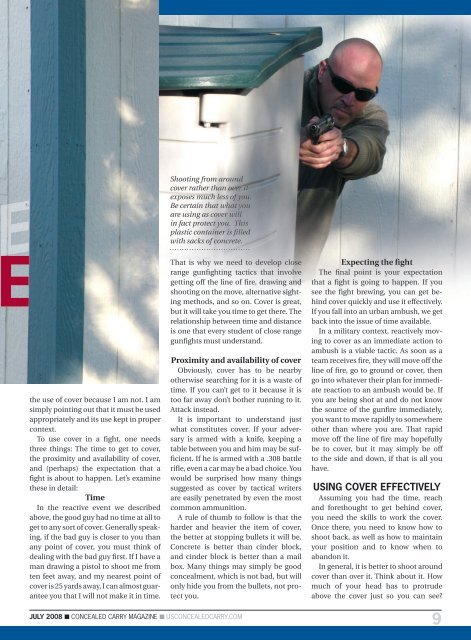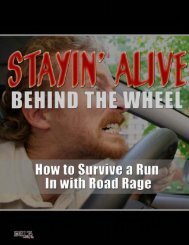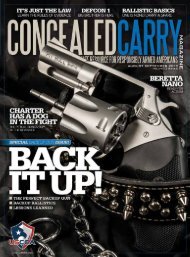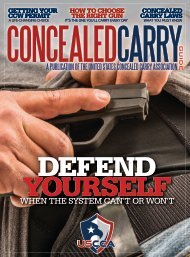Download This Issue - US Concealed Carry
Download This Issue - US Concealed Carry
Download This Issue - US Concealed Carry
Create successful ePaper yourself
Turn your PDF publications into a flip-book with our unique Google optimized e-Paper software.
Shooting from around<br />
cover rather than over it<br />
exposes much less of you.<br />
Be certain that what you<br />
are using as cover will<br />
in fact protect you. <strong>This</strong><br />
plastic container is filled<br />
with sacks of concrete.<br />
the use of cover because I am not. I am<br />
simply pointing out that it must be used<br />
appropriately and its use kept in proper<br />
context.<br />
To use cover in a fight, one needs<br />
three things: The time to get to cover,<br />
the proximity and availability of cover,<br />
and (perhaps) the expectation that a<br />
fight is about to happen. Let’s examine<br />
these in detail:<br />
Time<br />
In the reactive event we described<br />
above, the good guy had no time at all to<br />
get to any sort of cover. Generally speaking,<br />
if the bad guy is closer to you than<br />
any point of cover, you must think of<br />
dealing with the bad guy first. If I have a<br />
man drawing a pistol to shoot me from<br />
ten feet away, and my nearest point of<br />
cover is 25 yards away, I can almost guarantee<br />
you that I will not make it in time.<br />
That is why we need to develop close<br />
range gunfighting tactics that involve<br />
getting off the line of fire, drawing and<br />
shooting on the move, alternative sighting<br />
methods, and so on. Cover is great,<br />
but it will take you time to get there. The<br />
relationship between time and distance<br />
is one that every student of close range<br />
gunfights must understand.<br />
Proximity and availability of cover<br />
Obviously, cover has to be nearby<br />
otherwise searching for it is a waste of<br />
time. If you can’t get to it because it is<br />
too far away don’t bother running to it.<br />
Attack instead.<br />
It is important to understand just<br />
what constitutes cover. If your adversary<br />
is armed with a knife, keeping a<br />
table between you and him may be sufficient.<br />
If he is armed with a .308 battle<br />
rifle, even a car may be a bad choice. You<br />
would be surprised how many things<br />
suggested as cover by tactical writers<br />
are easily penetrated by even the most<br />
common ammunition.<br />
A rule of thumb to follow is that the<br />
harder and heavier the item of cover,<br />
the better at stopping bullets it will be.<br />
Concrete is better than cinder block,<br />
and cinder block is better than a mail<br />
box. Many things may simply be good<br />
concealment, which is not bad, but will<br />
only hide you from the bullets, not protect<br />
you.<br />
Expecting the fight<br />
The final point is your expectation<br />
that a fight is going to happen. If you<br />
see the fight brewing, you can get behind<br />
cover quickly and use it effectively.<br />
If you fall into an urban ambush, we get<br />
back into the issue of time available.<br />
In a military context, reactively moving<br />
to cover as an immediate action to<br />
ambush is a viable tactic. As soon as a<br />
team receives fire, they will move off the<br />
line of fire, go to ground or cover, then<br />
go into whatever their plan for immediate<br />
reaction to an ambush would be. If<br />
you are being shot at and do not know<br />
the source of the gunfire immediately,<br />
you want to move rapidly to somewhere<br />
other than where you are. That rapid<br />
move off the line of fire may hopefully<br />
be to cover, but it may simply be off<br />
to the side and down, if that is all you<br />
have.<br />
Using cover effectively<br />
Assuming you had the time, reach<br />
and forethought to get behind cover,<br />
you need the skills to work the cover.<br />
Once there, you need to know how to<br />
shoot back, as well as how to maintain<br />
your position and to know when to<br />
abandon it.<br />
In general, it is better to shoot around<br />
cover than over it. Think about it. How<br />
much of your head has to protrude<br />
above the cover just so you can see?<br />
JULY 2008 n CONCEALED CARRY MAGAZINE n <strong>US</strong>CONCEALEDCARRY.COM
















